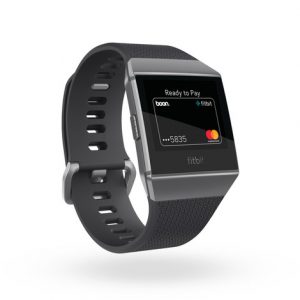With the introduction of transactional capability on smart watches and fitness trackers like the Apple Watch and Fitbit, the payments industry has eyed wearable devices as a field laden with potential for growth. Just how much growth came into focus this week with new figures and projections from International Data Corp., the Framingham, Mass.-based research firm.
Worldwide shipments of wearable devices will reach 132.9 million this year, with so-called basic wristbands (35.9%) and smart watches (32.8%) claiming the largest shares, according to IDC. Shipments will total 219.4 million in 2022, for a 13.4% average annual growth rate.

Smart watches will gain share over the next five years, claiming 38.3% of shipments, while wristbands, seen as an inexpensive “starter device” in the wearables category, will slide to a 22% share, IDC projects..
Other wearable categories that barely register today will account for a larger share of shipments by 2022, though they will still fall well behind smart watches and so-called basic watches in popularity. Earware and clothing, for example, will claim 6% and 5.3% shares, respectively, compared to 3.1% and 2.1% this year.
The added utility of watches, especially the computational capability of smart watches, account for their growing popularity and lay the groundwork for further payments applications, say IDC analysts.
“Consumers are finally starting to understand and demand the utility of a smart watch,” said Jitesh Ubrani, senior research analyst for IDC Mobile Device Trackers, in a statement. “At present, fitness uses lead by a mile, but mobile payments and messaging are starting to catch on.”
But connectivity will also drive smart-watch sales, he says, adding, “The addition of cellular connectivity is also starting to resonate with early adopters, and, looking ahead, the emergence of new use cases like music streaming or additional health sensors will make cellular connectivity pivotal to the success of the smart watch.”
The most well-known example today is the Apple Watch. Launched three years ago, the device includes near-field communication capability so it can work with Apple Pay. Apple is characteristically tightlipped about its sales, but at least one researcher estimates the company has shipped 33 million copies since the launch.
More fitness-oriented watches have emerged to compete with Apple in the payments arena. Fitbit Inc. and Garmin Ltd. have launched Fitbit Pay and Garmin Pay, respectively, for example. These payment-enabled devices work with select bank card issuers. Last month, however, a San Francisco-based startup called Fit Pay Inc., which provides the platform behind Garmin Pay, announced a coin-shaped device called Flip that will convert Bitcoin into fiat currency for use at any store.
Sales of at least some watches, however, may be hampered by high price tags. Apple’s Watch Edition Series 3 fetches $1,349 at retail, for example. There are also persistent concerns about security, particularly concerns about so-called distributed denial-of-service attacks that can shut down Internet of Things networks.
But the outlook for more basic watches may not be as much affected by such concerns, according to the IDC analysts. “The appetite for wristbands and basic watches will not go away,” said Ramon T. Llamas, research director for IDC’s Wearables team, in a statement. “Both products will enjoy sustained popularity as users’ first wearable thanks to their simplicity and lower price points.”



